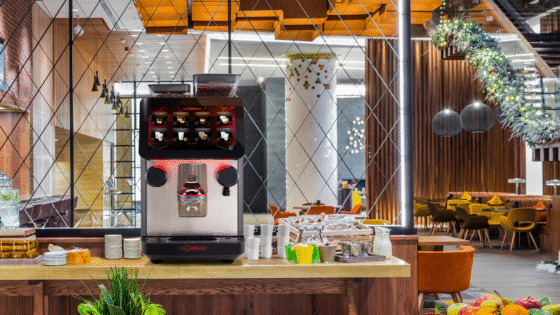Following lengthy debates regarding technology that took place at Hotel Designs LIVE, editor Hamish Kilburn caught up Technological Innovations Group’s Director of Hospitality, Leisure and Retail (EMEA) Christophe Malsot…
Technological Innovations Group (TIG) was the headline sponsor of Hotel Designs LIVE, the new one-day virtual conference that was born out of the idea to keep the industry connected and talking during the pandemic.

Following my address to the audience of designers, architects, hoteliers and developers, I took five minutes ahead of going live to the first seminar of the day to speak to the brand’s Director of Hospitality, Leisure and Retail (EMEA), Christophe Malsot. In the quick-fire interview, I wanted to know more about the TIG ‘ecosystem of solutions’, understand how its meeting new demands of modern travellers and users as well as understanding Malsot’s view on where technology in hospitality is heading.
Hamish Kilburn: Christophe, in a sentence, what does Technological Innovations Group (TIG) do?
Christophe Malsot: We are an EMEA sales agency offering an ecosystem of brands at the forefront of leading-edge technology development – we provide a full range of AV, UC, IT and control solutions that work together to create superior smart spaces that transform your future!
HK: Your vision is to create smart spaces that transform the future. Define a smart space?
CM: Smart Spaces connect people and technology in new ways: they add real value and are created with the latest AV/UC solutions that work together seamlessly to provide a convenient, efficient and secure user experience.
The term refers to a space that uses Internet of Things to connect every device with a simple, intuitive and user-friendly control solution. This significantly enhances the customer experience, and increases their loyalty to you.
For example, hosting a large group seminar or conference is easier than ever before. Guests will be impressed by the ease with which they can run their presentation and control the technologies in the room. Wireless presentation systems offer flexibility, enabling guests to stream uncompressed video from any laptop or mobile device, with just the touch of a button. Hosts can enjoy full control over the lighting, shades, temperature, and audio volume in the room through a simple touch screen. With cost-effective and energy-efficient technologies such as occupancy sensors and room scheduling software, the lighting and AV systems automatically shut down when the room is empty. And any system troubles can be remotely solved.
HK: On your website, you mention that TIG is an eco-system of solutions for smart spaces, can you explain what you mean by this?
CM: At TIG, we work hard to push the boundaries of technological integration for Smart Spaces. We offer a solutions-based approach to your current and future needs. There is no ‘one size fits all’, so our portfolio includes solutions that complement one another to create bespoke experiences. Our biggest technology provider is Crestron, and Crestron always sits at the heart of our ecosystem. But the other brands we represent work together to perfectly complete the desired user experience!
To help people understand how our ecosystem works, we have actually just launched a new Virtual Experience Space on our website, where visitors can see smart space examples, which demonstrate how the technologies integrate.
Our portfolio includes beautiful control hardware, AV and electricity remote management, applications and software, room booking, and furniture designed to fit in perfectly with specific technologies, making meeting rooms sleek and stylish.
“Technology will be a game changer for the hotel industry in a post-pandemic world.” – Christophe Malsot, Director of Hospitality, Leisure and Retail (EMEA), TIG.
HK: How has tech become more relevant since Covid-19?
CM: Technology will be a game changer for the hotel industry in a post-pandemic world, as it helps to cater to new habits and a different user experience.
“Customers will expect more technology to reduce the risk of contamination.” – Christophe Malsot, Director of Hospitality, Leisure and Retail (EMEA), TIG.
The hospitality industry will need to offer more contactless, but still very personalised, experiences for guests. For instance, their own smartphones will be used to manage most things, such as check in and check out, to open their room, control their environment and entertainment (Audio/Video), and get in touch with the staff or the concierge… with or without app downloading! Crestron uses QR code flashing to provide a beautiful HTML 5 layout on the phone or tablet.
Hotels need to review their existing service offerings so as to adapt to the changes in customer experience. Customers will expect more technology to reduce the risk of contamination. In order to maintain social distancing, virtual hotel tours will help to introduce the different spaces, and solutions will indicate the occupancy, availability and cleanliness status of the common areas such as gyms, restaurants, bars… For example, in meeting rooms and lobbies, expect to see fewer chairs and digital information about the last time they were used/cleaned.
Restaurants in hotels may start using contactless delivery for in-room-dining and digital menus… Paper will disappear!
HK: From a tech perspective, what will be the biggest change/evolution post-pandemic?
CM: The move to contactless control. For example, upon entering the hotel, the doors may open automatically, before you enter the elevator, you might tell it where you’d like to go with your voice, rather than pressing the many buttons. When you reach your room, you can enter with your smartphone instead of a key and sensors will turn the lights on…
Also, inside the guestrooms the learning curve must be close to zero… if you spend the whole evening understanding how the room works, you become frustrated. It needs to be quick and touchless for the guest to remain loyal.
These are just the changes the guest will see. Less noticeable in the post-coronavirus hotel would be more frequent cleaning policies, antimicrobial properties woven into fabrics and materials, amped-up ventilation systems, or even the addition of UV lights for more thorough disinfecting of the common areas at night.
Due to the reduction of travel and the increased usage of videoconferencing, the meeting rooms will have to provide an element of remote communication as well. TIG offers advanced remote collaboration tools from Hoylu.
HK: In a sentence, what’s the biggest innovation in technology in hotel design right now?
For a long period guests were able to find services they did not have in their home like international channels. Nowadays, hotel clients and international travellers have everything they need at home and they want to find the same experience in the guestroom. This means that BYOD connection is especially important. Hoteliers have to provide guests with the capacity to use their own devices to control the TV, to manage presentations in the meeting room, to connect to playlists for music, and communication apps such as Zoom, Teams… this is now a must have!
The perfect user experience will come from ergonomics and, to provide a perfect integration, the technology systems need to be built into the hotel’s design from the very beginning. Having the right networks (Electricity and IP) in place is hugely important! This is the only way to guarantee the perfect guest and staff experience.
Main image credit: Technological Innovations Group




